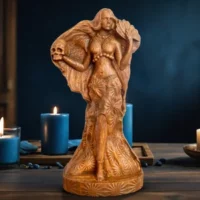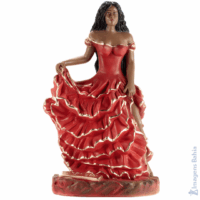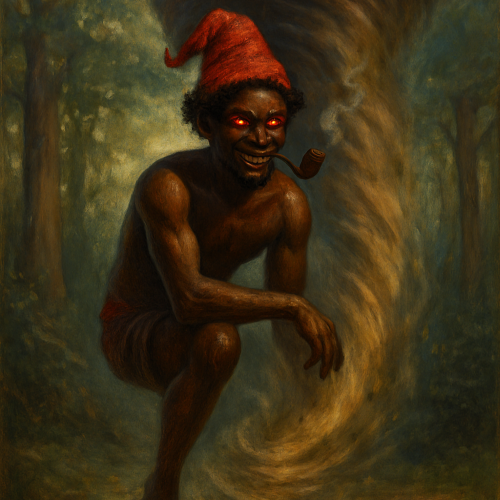Pomba Gira : The Spirit of Desire
Listen
At a glance
| Description | |
|---|---|
| Origin | South American Mythology |
| Classification | Spirits |
| Family Members | N/A |
| Region | Brazil |
| Associated With | Desire, Seduction |
Pomba Gira
Introduction
Pomba Gira is one of the most fascinating and controversial spirits in Afro-Brazilian religions, particularly in Umbanda and Quimbanda. She is not an Orixá like those venerated in Candomblé, but rather a powerful spirit who occupies a central place in rituals of love, desire, and empowerment. Pomba Gira is deeply connected to the symbolism of the crossroads, where choices, transformation, and encounters with the spiritual world take place. Her name is believed to derive from the Kikongo phrase Mpamba Nzila, meaning “crossroads,” a fitting description of her role as an intermediary between material and spiritual realms.
Unlike many other spiritual figures in Brazil, she does not descend from African pantheons but developed uniquely in Brazil’s cultural and religious context, shaped by African, Indigenous, and European influences. To her devotees, she represents liberation, sensuality, and independence, often embodying what society deems dangerous or taboo about femininity. Seen by some as a goddess of love and abundance and by others as a demonic figure, Pomba Gira challenges rigid boundaries and embodies a powerful archetype of feminine energy.
Physical Traits
Depictions of Pomba Gira emphasize her irresistible beauty and sensuality. She is commonly portrayed as a woman in red and black dresses, adorned with jewelry, and wearing high heels. Cigarettes, cigars, red roses, and champagne are among her symbolic accessories, highlighting her connection with pleasure and indulgence. Her laughter, often described as a throaty, commanding cackle, signals her presence during rituals and possessions.
Some images of Pomba Gira portray her as flirtatious and provocative, while others emphasize her regal side, showing her as a queenly figure who exudes dignity and command. In certain representations, she even takes on darker or more demonic forms, with horns, hooves, or devilish attributes, underscoring the fear and fascination she inspires. Regardless of form, her appearance conveys unapologetic femininity, one that is powerful rather than submissive, breaking away from traditional notions of womanhood.
Family
Pomba Gira is often described as the feminine counterpart to Exu, the trickster spirit and messenger of the Orixás. While Exu embodies masculine sexuality and vitality, Pomba Gira expresses the mysteries of female desire and power. Their relationship is symbolic rather than exclusive—she is sometimes called his consort or wife, but she is never bound to him. In fact, one of her defining traits is independence: she belongs to no man, no master, and no hierarchy.
Oral traditions suggest that some manifestations of Pomba Gira may stem from the spirits of women who lived outside of societal norms—prostitutes, courtesans, betrayed lovers, or women condemned for their defiance. In Quimbanda cosmology, she represents a reincarnated force that returns to guide others toward liberation and to punish those who oppress. Legends sometimes refer to her as having multiple husbands, an idea symbolizing her refusal to be tied down by patriarchal rules.
Other names
One of Pomba Gira’s most distinctive features is her multiplicity. She manifests in many avatars, or falanges (“phalanges”), each with its own personality and area of influence. These variations allow practitioners to call upon specific aspects of her spirit depending on the need.
Among her most prominent avatars is Maria Padilha, a figure inspired by the historical Castilian noblewoman associated with love, betrayal, and occult knowledge. Maria Padilha is often seen as the archetypal Pomba Gira, embodying her majesty and depth. Other notable forms include Pomba Gira das Sete Encruzilhadas (of the Seven Crossroads), who governs intersections of destiny; Pomba Gira Cigana (the Gypsy Pomba Gira), associated with fortune-telling and mystery; and Maria Mulambo, whose association with poverty and hardship reflects resilience and transformation.
Names such as Rosa Caveira (Skull Rose), Rainha das Almas (Queen of Souls), and Dama da Noite (Lady of the Night) reflect her connection with the night, spirits of the dead, and the hidden aspects of human desire. These avatars show the complexity of her spiritual nature, ranging from glamorous seductress to fierce guardian of souls.
Powers and Abilities
Pomba Gira’s powers are primarily linked to matters of love, sexuality, and personal freedom. She is invoked in rituals to attract passion, rekindle broken relationships, or break harmful emotional ties. As a spirit of desire, she can both grant and withdraw affection, making her influence sought after in cases of unrequited love or betrayal.
Beyond romance, Pomba Gira is a protector of the marginalized. Women, LGBTQ+ devotees, and sex workers often turn to her for empowerment and spiritual support. Her possession rituals provide spaces for individuals to express identities that society stigmatizes, reinforcing her role as a liberating force.
She is also known for her oracular abilities. Through spirit possession, she delivers blunt and uncompromising truths, often accompanied by gestures of laughter, smoking, or drinking. Her insight is especially valued for guidance in situations of conflict, heartbreak, or injustice. At times, she can be fierce and vengeful, punishing those who exploit or harm others. Her connection to graveyards and crossroads further cements her role as a spirit who mediates between life, death, and destiny.
Modern Day Influence
In modern Brazil, Pomba Gira continues to be a central figure not only in religion but also in culture and art. Statues, songs, and paintings often depict her as both alluring and formidable, a woman who embodies freedom and defiance. Writers and scholars have analyzed her symbolism as a reflection of Brazil’s struggle with colonial legacies, gender inequality, and the stigmatization of Afro-Brazilian traditions.
Her influence extends beyond religious spaces into social and cultural life. Within Umbanda and Quimbanda, she is invoked during ceremonies for love, protection, and empowerment, and her rituals often involve offerings of flowers, perfumes, liquor, and tobacco. For many, she is the ultimate symbol of feminine autonomy, standing against patriarchal and colonial systems that sought to suppress women’s agency.
Her connection to marginalized communities remains strong, particularly among transgender women and effeminate men, who find in her a spiritual ally who validates their identity and strength. Pomba Gira’s cult highlights the resilience of those excluded by mainstream society, offering them not only spiritual guidance but also cultural affirmation.
While some conservative groups continue to label her as demonic, her popularity grows as a symbol of resistance and self-determination. Pomba Gira stands as a reminder that spirituality can embrace desire, pleasure, and freedom without shame. Her enduring presence in Brazilian religious and cultural landscapes reflects a dynamic figure who continues to evolve with the communities that venerate her.
Related Images
Source
Nunes, A. (1970). Umbanda: religião-desafio. Rio de Janeiro: Editora Espiritualista.
Wikipedia contributors. (2023). Pomba Gira. Wikipedia. https://en.wikipedia.org/wiki/Pomba_Gira
Love Magic Works. (2022). Pomba Gira: Who it is, history, characteristics and much more. https://lovemagicworks.com/pomba-gira-who-it-is-history-characteristics-and-much-more/
Mythology Guru. (2023). Quimbanda: Afro-Brazilian Mythological Religion. https://mythology.guru/quimbanda-afro-brazilian-mythological-religion/
Frequently Asked Questions
What is lorem Ipsum?
I am text block. Click edit button to change this text. Lorem ipsum dolor sit amet, consectetur adipiscing elit. Ut elit tellus, luctus nec ullamcorper mattis, pulvinar dapibus leo.
What is lorem Ipsum?
I am text block. Click edit button to change this text. Lorem ipsum dolor sit amet, consectetur adipiscing elit. Ut elit tellus, luctus nec ullamcorper mattis, pulvinar dapibus leo.
What is lorem Ipsum?
I am text block. Click edit button to change this text. Lorem ipsum dolor sit amet, consectetur adipiscing elit. Ut elit tellus, luctus nec ullamcorper mattis, pulvinar dapibus leo.
What is lorem Ipsum?
I am text block. Click edit button to change this text. Lorem ipsum dolor sit amet, consectetur adipiscing elit. Ut elit tellus, luctus nec ullamcorper mattis, pulvinar dapibus leo.
What is lorem Ipsum?
I am text block. Click edit button to change this text. Lorem ipsum dolor sit amet, consectetur adipiscing elit. Ut elit tellus, luctus nec ullamcorper mattis, pulvinar dapibus leo.










